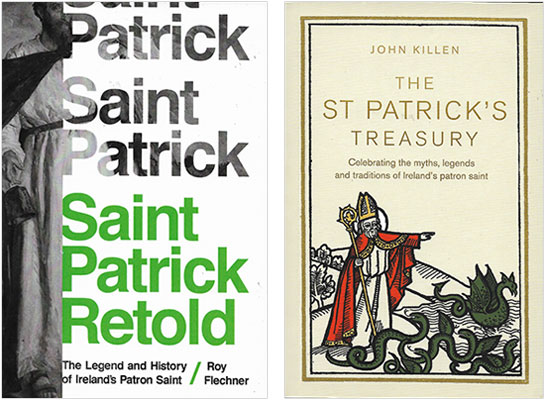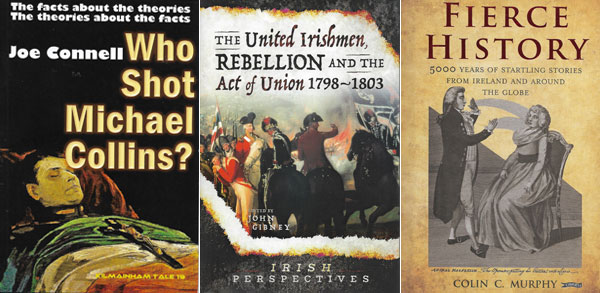BOOKWORM
Published in Book Reviews, Issue 2 (March/April 2019), Reviews, Volume 27By Joe Culley
@TheRealCulls

About halfway through his superb new biography of St Patrick, Roy Flechner, while referring to an earlier standard work, writes: ‘The present study, it is hoped, is just as successful in attaining the coveted status of “least improbable”’. Saint Patrick retold is that rare amalgam of academic rigour married to stylish storytelling which will appeal as much to the general reader as to those engulfed in the discipline.
Flechner, a lecturer in early medieval history at UCD, has used as the foundation of his work the most current evidence, particularly that of archaeology and of Roman law, to ‘reconstruct the wider historical context in which [Patrick] lived’. Thus an outline emerges ‘when we concentrate not so much on the person himself but rather on his background’. Among the chapters, which are meant to stand on their own, are ‘Patrick’s Britain’, ‘Patrick’s Ireland’ (in which the vexed question of ‘Celtic’ identity is tackled), ‘Religion in Britain and Ireland’ and ‘The Missionary Life’, and each is an engaging mini-survey of our modern understanding.
All this leads to the hypothesis that Patrick may, perhaps, have chosen to settle in Ireland to avoid the inherited role of tax collector. And while all of this is presented in a manner accessible to the layman, one suspects that there could be some bloodletting in the halls of academia, for Flechner’s interpretations will not go unchallenged. It seems that Patrician scholarship is as riven by professional rivalry as Joycean studies, but one also suspects that Saint Patrick retold will indeed be the new standard of least improbable.
A timely companion piece to Retold is John Killen’s lovely The St Patrick’s Treasury: celebrating the myths, legends and traditions of Ireland’s patron saint. Killen, a former head of the Linen Hall Library in Belfast, has compiled a wealth of earlier material touching on every aspect of the saint’s legend, from an 1887 translation of the Confessio to a brief study of the grounds of Cashel to a Patrick Kavanagh poem. Beautifully illustrated.
As we move into the centenaries of the War of Independence and the Civil War, the theme of reprisals will be to the fore. One of the most significant—or dramatic, comprehensive, notorious and, yes, incendiary—came on the night of 11–12 December 1920, when British forces set fire to the heart of Cork city. The north-eastern side of Patrick Street was razed and the City Hall and neighbouring Carnegie Library were gutted. Even the genteel residents of Montenotte could not escape the violence, as several homes at Dillon’s Cross were burned. The mayhem followed two ambushes of Auxiliary forces, one earlier that day at Dillon’s Cross, the other a fortnight earlier when, more famously, the IRA had killed seventeen Auxiliaries at Kilmichael.

Local author Michael Lenihan tells the story in the excellent Cork burning, a beautifully produced hardback from Mercier Press. Many of the superb images will be unfamiliar even to denizens of the southern capital, as they come from Lenihan’s private collection, compiled over several decades. Lenihan paints a lovely picture of the city’s cultural and political life in the run-up to the atrocity, details the violence in the region leading up to it, and examines the consequences, both political and financial, of the conflagration. For those of us with a grá for the city, it’s a ‘must have’.
Another handsome hardback to come our way is Vincent Carmody’s self-published Listowel: a printer’s legacy. While the town had three printing workshops, Carmody’s focus is on the work of Bob Cuthbertson, who, in the words of frequent collaborator Bryan MacMahon, ‘printed anything and everything. Invitations, handbills, pamphlets, lists of fairs and markets … raffle tickets, ballad sheets, dance and play posters …’. Indeed, MacMahon was renowned for composing traditional ballads, which were then set by Cuthbertson. In the case of this volume, Listowel Printing Works can take credit for its fine appearance.
A third fine illustrated hardback is Michael B. Barry’s The fight for Irish freedom: an illustrated history of the War of Independence. Barry has previously similarly addressed the Rising and the Civil War, and this completes the trilogy. Included are some 650 images, some previously unpublished, along with the author’s own photographic work.
In Four Courts’ continuing series of portraits of cities during the revolution, Adrian Grant tackles Derry: the Irish Revolution, 1912–23. The city was unique in its demographics and geography. Obviously, the question of partition was at the forefront of nationalist concerns, as was the constant threat of purely sectarian violence. After the First World War the city was heavily garrisoned by British forces, which forced the local IRA to develop tactics separate from those sent from HQ—when they were sent at all. Grant presents a perspective that is ordinarily overlooked.

Our own Joe Connell, who knows a thing or two about Michael Collins, has for some reason or other decided to stride into the historical minefield that is the question, Who shot Michael Collins? Joe has distilled the newest material on the controversy to, as the subtitle says, address all the facts about the theories and all the theories about the facts. You’ll have to read Joe’s pamphlet to learn the truth.
Colin Murphy is building a reputation as a popular chronicler of the eccentric, and Fierce history: 5,000 years of startling stories from Ireland and around the globe is just that. It includes the flaming camels of Mongolia and the woman employed to test-drive Catherine the Great’s lovers.
In the second instalment of the collaboration between History Ireland and English publishers Pen and Sword, John Gibney has edited The United Irishmen, rebellion and the Act of Union 1798–1803, a collection of essays from our archives which have been re-edited and in which some of the world’s leading experts on the 1790s explore the origins, nature and aftermath of the decade from a range of perspectives.
Roy Flechner, Saint Patrick retold: the legend and history of Ireland’s patron saint (Princeton University Press, £22 pb, 304pp, ISBN 9780691184647).
John Killen, The St Patrick’s Treasury: celebrating the myths, legends and traditions of Ireland’s patron saint (Blackstaff Press, €14.99 pb, 264pp, ISBN 9780856409585).
Michael Lenihan, Cork burning (Mercier Press, €19.99 hb, 256pp, ISBN 9781781176245).
Vincent Carmody (ed.), Listowel: a printer’s legacy. The story of printing in north Kerry 1870–1970 (Vincent Carmody, [price?] hb, 220pp, ISBN 9780992698898).
Michael B. Barry, The fight for Irish freedom: an illustrated history of the War of Independence (Andalus Press, €24.99 hb, 304pp, ISBN 9780993355462).
Adrian Grant, Derry: the Irish Revolution, 1912–23 (Four Courts Press, €19.95 pb, 192pp, ISBN 9781846826597).
Joe Connell, Who shot Michael Collins: the facts about the theories, the theories about the facts (Kilmainham Tales, €6 pb, 30pp, ISBN 9781908056191).
John Gibney (ed.), The United Irishmen, rebellion and the Act of Union 1798–1803 (Pen and Sword Books, £19.99 hb, 162pp, ISBN 9781526736673).
Colin C. Murphy, Fierce history: 5,000 years of startling stories from Ireland and around the globe (O’Brien Press, €14.99 hb, 320pp, ISBN 9781788490290).
















